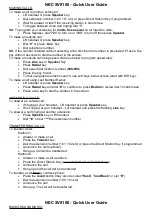
MERLIN LEGEND Communications System Release 5.0
Feature Reference
555-650-110
Issue 1
June 1997
Features
Page 195
Direct-Line Console
Feature Interactions
9
Alarm
A DLC operator uses an Alarm button to monitor system operation. The
red LED next to the Alarm button on the operator console goes on when
the system detects a problem that requires immediate attention. An
operator with an MLX DLC can use Inspect to display the number of
alarms; an operator with an analog DLC cannot use Inspect. On a system
with fewer than 29 lines, an Alarm button is factory-assigned to analog
DLCs with 34 or more buttons.
On a system with more than 29 lines, Alarm is replaced with line 30. The
Alarm button is not a fixed feature and can be assigned to any available
button on an analog or MLX DLC.
Allowed/
Disallowed Lists
Allowed and Disallowed Lists can be assigned to DLCs.
Auto Dial
An inside Auto Dial button can be programmed on a DLC. A DLC operator
can use the button to transfer a call, make an inside call, or determine
whether or not the extension is available.
Calling Restrictions
Calling restrictions can be assigned to DLCs to prevent users with
restricted extensions from bypassing restrictions by asking system DLC
operators with unrestricted consoles to connect them to an outside call.
Call Waiting and
Camp-On
When a DLC operator uses Camp-On to transfer a call to a busy
extension, the call is placed in the call-waiting queue and the caller hears
the call-waiting tone whether or not the extension has Call Waiting
activated. If the system is programmed for one-touch Transfer with
automatic completion, the operator uses Camp-On by pressing the
Transfer button, dialing the extension manually, activating Camp-On,
hanging up, and pressing either another line button or the Transfer
button again. If the operator presses an Auto Dial or DSS button, the
transfer is automatically completed and Camp-On cannot be used.
Coverage
A DLC can be both an Individual or Group Coverage receiver and a
member of a coverage group. No more than eight Primary Cover,
Secondary Cover, or Group Cover buttons can be assigned on a DLC. A
DLC can also be a sender.
When a DLC is used in a system with a CTI link and is not itself using a
CTI link application (that is, the DLC is unmonitored), calls transferred
from a Cover button on the DLC do not initiate screen pop, even at
screen-pop-capable destinations.
















































